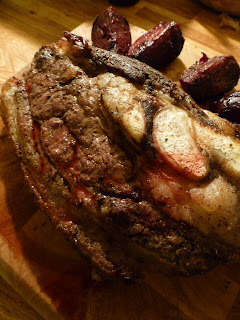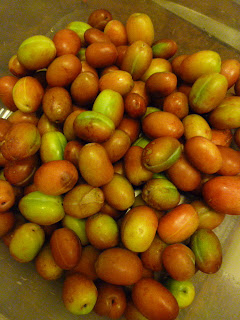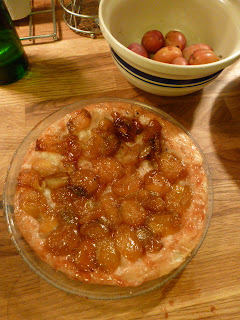It’s just coming up to two years since I started this blog. In fact it will be two years to the day next Monday since I uploaded my first proper post, the very first sentence of which ended “as I write this, it is bleak outside”. And while, at the precise moment of writing this particular sentence, the sun has actually come out over Dalston and is shining through my window, bleak is certainly what the weather has been this past couple of days, and still is over much of the country. Bleak being to put it mildly.
That first proper blog post was about wild mushrooms, and what a bumper year it was for
them in 2010. So far in 2012 I
haven’t had an opportunity to go out foraging, but from what I hear this is
certainly not a bumper year, nor anything like one. Like the widespread flooding of the last couple of days -
according to the lady from the Environment Agency I heard interviewed on the
radio earlier today (speaking on the subject of floods, not mushrooms) – this
is almost certainly down to the unusual pattern of this whole year’s weather,
swinging, as it has between drought and deluge (although that’s not
exclusive to this year).
Those same
weather conditions will almost certainly have an effect on the availability
(and therefore, obviously, price) of game birds, which like the birds in my own
back garden, if my own observations are anything to go by, will have struggled
to breed successfully. Although I
have yet to read any reports of the grouse season – which, like wild mushrooms, was a bumper one in 2010,
and again in 2011 – certainly the pre-season forecasts were, at best, mixed. I’ve
not yet been down to Theobalds to check out their prices on grouse this year, but I
doubt they’re knocking them out at a fiver a piece like they were a
couple of Christmases
back, and the cheapest I’ve seen elsewhere
have been the best part of twice that.
So it seems
that autumn’s arrived, but that the prospects of tucking into at least some of
the produce that makes this such a great time of year for a cook – or an eater
– are as bleak as the weather. But
don’t worry – the changing seasons in the kitchen are about how you cook as
much as precisely what you cook.
And grouse notwithstanding, there are always bargains to be had. Cheap cuts
of meat are the best for stews,
and the passing of summer sees the return of stewing
season, which is some considerable compensation in my book…
As it happens
though, we have yet to move on to big, hearty, autumnal stews, but we have
started roasting again. Not that
we ever entirely gave it up. It
was still distinctly Indian summery the Sunday before last when we went for a
walk down to the Columbia Road flower market and came back via the Brazilian
butchers on Mare Street. That I’ve long intended to visit. Long intended to but never previously
got round to, mainly through laziness or lack of decisiveness, of course, as in
all things. But at least in part
because of ethical doubts about importing
meat from Brazil. The food
miles for one thing, the destruction of the rain forest for another, what with
its global environmental impact and local genocidal ones. That’s more issues
than I’m necessarily looking for on my plate. So it’s something of an irony, then that I couldn’t help but
feel a pang of disappointment when the Brazilian butcher told me that he
sources his beef from Scotland.
On
reflection though, that is an eminently good thing – not least because Scottish
beef deserves its reputation as among the best in the world. Not, I would add the best. That is an
absurd claim, made by far too many people from far too many parts of the globe,
for any of them to be definitively (or even at all) correct. A bit like the existence of God then –
although at least in the case of beef we can legitimately make an evidence
based although still, obviously, entirely subjective judgment, and declare one
or other type of beef to be our personal favourite. Although I would make two observations about any attempt to
do so: 1. I really don’t see the point; and 2. People making any such claim, in
my experience, almost invariably come from the place of which the claim is
being made. Coincidence? Hmmm….
Anyway, back
to the Brazilian butcher and his Scottish beef. I didn’t ask him where he thought the world’s best beef came
from, but I did have to ask him what some of the cuts of meat he had listed on
his board, or laid on his slab actually were, because although the meat may
have been Scottish, the butchery and some of the terminology, was clearly
wholly Brazilian. The particular
cut I was most interested in was a brick like slab of meat, fat and bone, that
he simply identified as rib, and which definitely counted as one of those
bargains I referred to earlier, coming in at just £3.50 a kilo.
It was a very
similar cut to the more familiar although still not commonly seen British or American short
ribs, or the middle rib I wrote about here,
but cut on a different angle, with the ribs passing diagonally rather than
perpendicularly through the joint.
Whatever, at that price it was far too much of a bargain to resist, so
we took home the whole slab, which came to almost exactly a kilo. Or about £3.49’s worth.
As it was a
Sunday, we decided a straightforward roast was the obvious way to cook it. And as it was so similar to middle rib,
I took my previous experience with that as the starting point for my method. As I said at the end of my post on
middle rib, the next time I cooked it I would modify my normal roasting method
to reduce the ‘sizzle’ time, either browning the joint more thoroughly than
normal on the stove top before transferring to a cool oven for long gentle roasting,
or browning normally before transferring to a very hot oven but immediately
turning it down. I chose the
latter.
It seemed to work. I preheated the oven to about 250,
whacked in the joint, - first marinaded in a dry rub of crushed satr anise, English mustard
powder, salt and pepper, then well browned on all sides and propped up in its
roasting dish by two halves of onion and four quarters of beetroot freshly
pulled from the garden and briefly blanched - closed the oven door and turned
the dial down almost as low as it would go. To around 140 (as I’ve said before, my oven - which I love -
is not the most modern, and has no truck with all this newfangled, Heston
style roasting for 5 hours at 60 degrees malarkey. Not that I’m taking sides, and as
regular readers of this blog will be aware, I’m all in favour of long, slow
cooking. But still, if the process
being described as ‘roasting’ doesn’t involve the exposure of the thing being
cooked to intense heat for at least some of its cooking time, then I’m not
really sure what the word ‘roast’ actually means. Call me old fashioned. And, while I’m on the subject, if your oven’s stuck at 60 degrees for five or six
hours cooking your beef, how are you meant to cook all the other things you
might want to go with your beef?
Things like Yorkshire pud or roast potatoes that need a good hot oven? Fine for those with two ovens,
obviously, but how many of us have two ovens?
My method is
of course much less scientific than anything Heston would countenance. I’m really not at all sure how accurate
the temperature settings on my old oven are – although I have an oven
thermometer it is so difficult to read in the gloomy light of the oven that I
never bother - and I know nothing at all about its rate of cooling. All I can tell you is that when I
checked my joint after just half an hour it was looking pretty good, so I took
it out, and closer inspection on the board appeared to confirm that. After a good half an hours resting time,
I carved it – into big chunks, this is not a slicing joint – and indeed it was
just the right shade of pink.






























